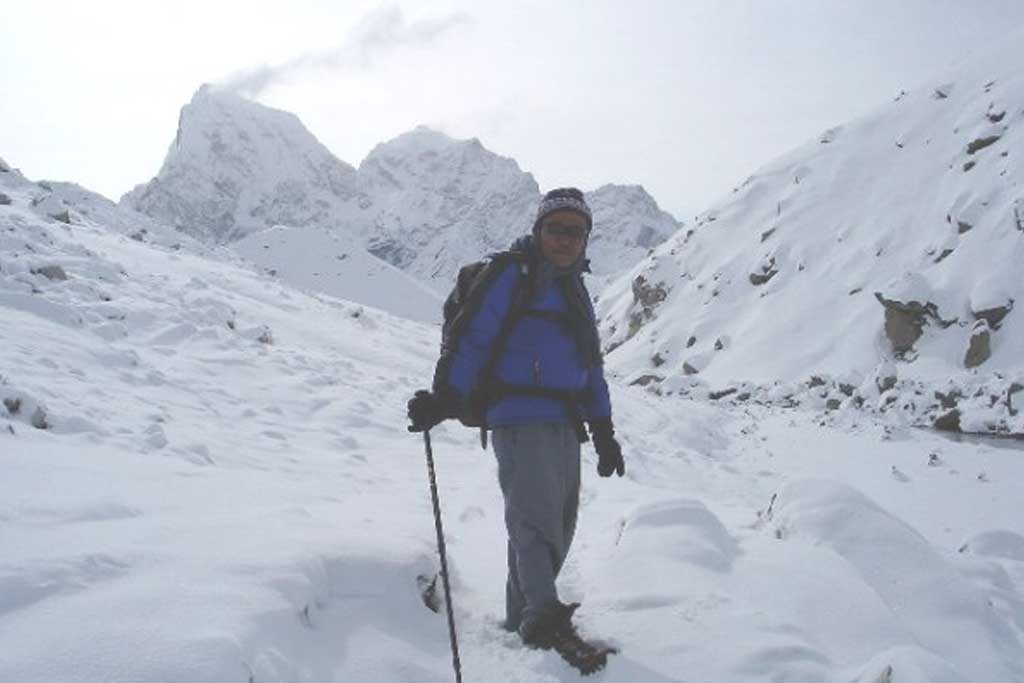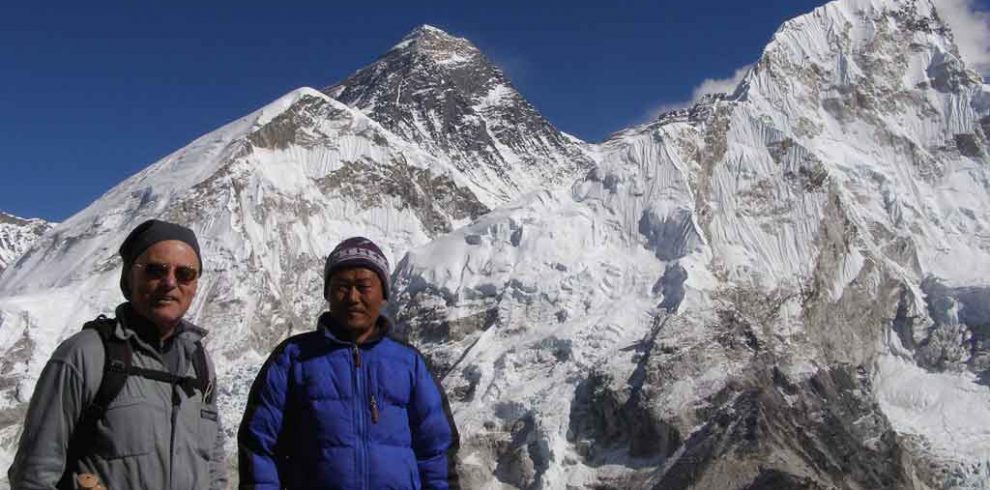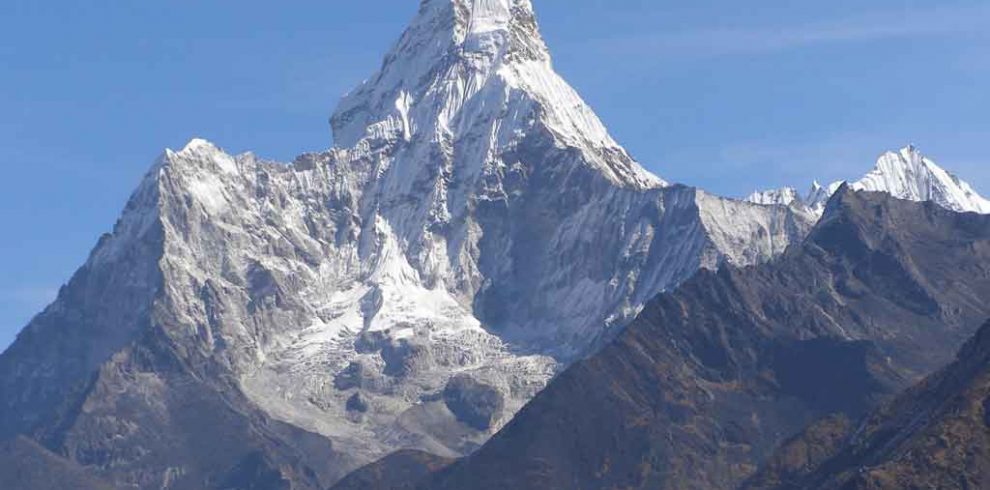The Gokyo Valley Chola Pass trek is one of the most adventurous treks in the Khumbu region. This unique trek goes through the home of the legendary Sherpa people- Namche Bazaar. The route then passes following the Dudh Koshi River to its source- the Gokyo Lake to the west of the Everest Base Camp.
The trek starts at Lukla reached after a 35-minute scenic flight from Kathmandu. Then we continue towards Namche Bazaar and all the way to Gokyo Valley, Chola Pass and finally Gorakshep. We will continue our journey to the Mount Everest Base Camp and Kalapatthar on the following day. Therefore, the Gokyo-Chola pass-Everest Base Camp trek is also known as the Everest Circuit trek.
Brief Itinerary:
| Day | Route | Altitude | Duration |
|---|---|---|---|
| 01 | Fly Kathmandu to Lukla, trek to Phakding | 2,610m/8,563ft | Trek: 3-4 hrs |
| 02 | Trek Phakding to Namche Bazaar | 3,446m/11,306ft | Trek: 5-6 hrs |
| 03 | Rest and acclimatisation day in Namche Bazaar | 3,446m/11,306ft | Free time |
| 04 | Trek Namche Bazaar to Dole | 4,200m/13,780ft | Trek: 5-6 hrs |
| 05 | Trek Dole to Machhermo | 4,470m/14,666ft | Trek: 3-4 hrs |
| 06 | Trek Machhermo to Gokyo | 4,790m/15,716ft | Trek: 3-4 hrs |
| 07 | Climb at Gokyo Ri in the morning | 5,360m/17,586ft | Trek: 2-3 hrs |
| 08 | Trek Gokyo to Thangnak | 4,950m/16,241ft | Trek: 3-4 hrs |
| 09 | Trek to Dzonglha crossing over Chola pass | 5,330m/17,487ft | Trek: 6-7 hrs |
| 10 | Trek Dzonglha to Lobuche | 4,910m/16,109ft | Trek: 2-3 hrs |
| 11 | Trek to Everest Base Camp, return trek to Gorakshep | 5,364m/17,598ft | Trek: 7-8 hrs |
| 12 | Trek/Climb to Kalapatthar, return trek to Pheriche | 5,545m/18,192ft | Trek: 7-8 hrs |
| 13 | Trek Pheriche to Namche Bazaar | 3,446m/11,306ft | Trek: 5-6 hrs |
| 14 | Return trek Namche Bazaar to Lukla | 2,840m/9,318ft | Trek: 6-7 hrs |
| 15 | Fly Lukla to Kathmandu | 1,350m/4,430ft | 35 minutes |
The exceptional Gokyo Valley Chola Pass trek rewards with the panoramic views of Cho Oyo, Makalu and Mt. Everest of course. The dramatic landscape from the summit of Gokyo Ri (5,360m/17,586ft) is truly impressive. One of the major attractions of this trek is the Gokyo Lake situated in the Gokyo Valley.
An excursion to the fourth and fifth lakes would be an extra adventure from Gokyo. Gokyo Ri refers to as the best view point in the entire Everest Region for more spectacular scenery than that from the Kalapatthar. We are then ready for the return trek to Lukla following through the beautiful Thyangboche monastery and Namche Bazaar.
Lobuche or Island Peak climbing is a popular trip extension to this trek.
Gokyo Ri Trek Difficulty
Our Gokyo Valley Chola Pass trekking itinerary is carefully designed so that trekkers can accommodate gradually with the changing altitude. Gokyo Ri lies at an elevation of 5,360 meters and helps a lot in order to acclimatize before crossing the challenging Chola pass.
It is a steep climb up to Gokyo Ri that offers amazing views of Mount Everest, Cho Oyu, Lhotse and Makalu. It takes about 3 hours to reach the Gokyo Ri top and return. The difficulty level of this trek is hard as it involves the Chola pass where part of the trail goes over ice.
On the Chola pass crossing day, it is important to start the trek very early in the morning- around 4 or 5 AM. Your leader will wake you up to begin the adventure. A head torch for each is necessary on this day. Another part of hardness of this trek is the altitude.
It may be beneficial if you have some experience of Himalayan trekking. Exercising regularly at home or hill walking for 5-6 hours a day (if possible) prior to the trip for few weeks can be a great asset. However, your passion is the major reason to make it a real once in a lifetime achievement.
Best Time for Gokyo Valley and Chola Pass Trek
The best time to trek to Gokyo Ri, Chola pass and Everest Base Camp starts from the middle of March to middle of June and from the beginning of September until November. Chola pass remains closed during winter. This part of the trek receives less number of trekkers in summer since the visibility of the mountains is poor due to the cloud in the sky.
Overview
- The challenging Chola pass (5,330m/17,487ft)
- The spectacular views from Gokyo Ri
- The Gokyo valley with the blue Gokyo Lake
- Magnificent views of Mt. Everest Himalayan range
- Amazing view of the Khumbu Ice-fall
- Scenic mountain flight to/from Lukla










